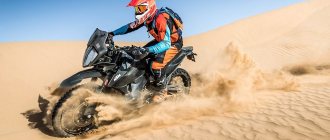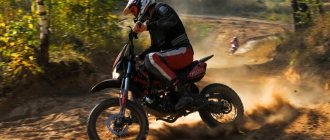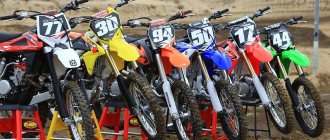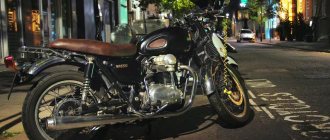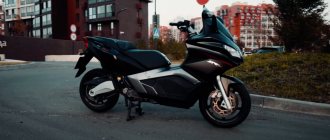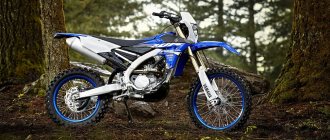Among the flagships of the motorcycle industry around the world there are several companies that constantly delight motorcycle lovers with new models. One such company is Kawasaki. Among the wide variety of designs, the Kawasaki z1000, which was first released in 2003 as a successor to the “Z” line, produced in the 1970s and which managed to become legendary, is in particular demand among bikers. But from its predecessor, the Kawasaki z1000 borrowed a steel frame, plastic linings and a deformed engine installed on the ZX-9R. In its modern design, this bike is mounted on a duplex aluminum alloy frame and is equipped with a fairly powerful engine, the volume of which has been increased.
History and basic models
If we touch on history, from 2003 to the present day several main series of the bike have been released:
- 2003-2009 - the first line to use a 953 cc engine. cm and steel frame from the 70s model;
- 2010-present - second series with an internal combustion engine of 1043 cc. see and tubular aluminum frame.
During this time, intermediate modifications also appeared, but they did not particularly affect the development of this series of motorcycles. It is worth immediately noting the features of the 2016 z1000 - a 4-cylinder injection engine, a duplex frame, piston brakes, a sports suspension, a 6-speed gearbox and a weight of about 200 kg. The engine that is installed on the second generation of this motorcycle can be found on the Kawasaki Versus 1000 enduro-tourist class.
Today, two versions of the Kawasaki z1000 are in demand on the world market - a traditional street bike and the Z1000SX - a modified one that looks like a sports bike, equipped with a fairing, wheel rotation control and the ability to select one of the engine operating modes. If we talk about the main competitors of this bike model, then these are the Yamaha FZ1/Yamaha MT-10, Honda CB1000R and Suzuki GSX-S1000.
General ergonomics of the bike
There are not so few owners of the Kawasaki Z1000, as this motorcycle has been pleasing those who love speed and power hidden under an original and slightly aggressive design for many years. You just have to look at the bike and the first thing your gaze stops at is the updated dashboard, on which the company’s engineers have worked hard. It's completely digital, with an interesting orange backlight that gives it a somewhat futuristic look. An interesting feature of the panel is that it can be adjusted to a specific viewing angle depending on the height of the motorcyclist and his riding preferences (three positions are available, adjustable with a special handle located on the left). On the panel you can find a speedometer, tachometer, odometer, clock and fuel level indicator in the tank.
The tank is made in a supersport style, so it is very easy to squeeze it with your knees. On the Internet you can find thousands of photos of this motorcycle, which show its slightly aggressive style, which goes well with the smooth lines of the fairings. Despite the fact that at first glance the steering wheel is wide, the motorcyclist, sitting slightly leaning forward, sits absolutely confidently.
If we talk about the technical characteristics of the brakes, they deserve special attention in this model. At the front, there are 300 mm petal brake discs equipped with four-piston radial calipers. At the rear there is a single-piston caliper with a 250mm petal disc. The 2016 Kawasaki z1000 modification is equipped with ABS, the presence of which greatly simplifies the control of the bike.
Kawasaki Versys 1000S
If you like a spirited ride in the company of sportsmen, but prefer comfortable suspension and a comfortable seating position, and at the same time want to be able to lean out on the ground or walk many hundreds of kilometers a day on cruise control, then the Kawasaki Versys 1000 S is created just for you. He is capable of all this, and is especially great at sports driving.
Assistants Kawasaki Versys 1000 S
The motorcycle is equipped with the latest generation of on-board electronics and electronic assistants, and it has almost all the modern motorcycle features on the market. Three-mode switchable KTRC traction control, electronic cruise control, six-axis Bosch inertia meter, KCMF cornering control system, KIBS smart braking system, integrated riding modes, traction modes, KQS quickshifter, light-slip slipper clutch, LED cornering lights - A very strong set even by the most picky standards.
And, of course, the motorcycle's dashboard is equipped with a Bluetooth module to connect with a smartphone running the Rideology The App, which allows you to configure the Versys directly from your phone while stopping (for example, sitting down for a snack in a cafe) - the updated settings will be transferred to the motorcycle after it launch. And in order to impress fellow travelers, there is a cool function of displaying the maximum angle of inclination in both directions. I got 47 and 46 degrees - not bad for a tourer, right? It has very good clearance in corners, and you don’t have to worry about bumps when leaning, but more on that later.
Chassis and handling
When rolling the Versys, especially with a full tank, you need to be extremely careful because it tends to lie down. The Kawasaki Versys 1000 S has a high center of mass and requires confident and skillful handling. However, in the saddle such weight distribution is felt only at very low speeds - for example, when you make your way between the rows at a snail's pace. A little rear brake, grip in the gray zone - and the motorcycle becomes much more stable and controllable.
Kawasaki Versys 1000S
Everything else about the motorcycle is not just acceptable, but very pleasant: a soft, smooth and informative clutch, zero vibrations in the mirrors (which, however, are small and oddly shaped), a good gearbox (with a slightly flimsy foot), and a high level of comfort for everyday riding. Due to the wide motor, it can be a little hot in the foot area, but in cool weather it’s even pleasant.
Ease of riding for two on the Kawasaki Versys 1000 S
The Kawasaki Versys 1000 S rides great for two people, but getting into the saddle and dismounting is not very convenient for a passenger. In the city, riding as a couple is complicated by the fact that weight distribution becomes even worse - simply because the passenger sits much higher than the rider. But she can see quite well over my helmet. Handling at the stock suspension settings is, let’s say, not very good: the fork works fine, but the rear suspension quickly becomes uncomfortable on a series of bumps and loses its normal rebound. Fortunately, setting it up for two-person driving is absolutely not difficult.
The passenger seat is comfortable, the footrests and handles are not bad, but still my passenger complained that she stuck out like a pole in a field on this motorcycle, and it made her feel uncomfortable and scared. An odd position for a sport-touring model—a lower seat for a two-person seat would be much more comfortable.
Engine and transmission
Numerous reviews about this model indicate that Kawasaki engineers did everything to make the motorcycle as fast and comfortable to ride as possible. Especially for this purpose, the front part of the Kawasaki z1000 motorcycle is made heavier, so at high speeds the bike does not wobble, but confidently holds its direction.
According to reviews from Kawasaki z1000 owners from 2010-2016. It is positioned as a sportbike, and accordingly, the engine installed on it is quite powerful. 16-valve engine with a volume of 1043 cc. cm with four cylinders with additional liquid-type cooling allows you to get power up to 142 horsepower at 10,000 rpm. The intake is injection, so detonation occurs without additional delays. The engine starts using an electric starter, which is very convenient.
The manual transmission is implemented in the Kawasaki style - out of 6 gears, the first two are long and the rest are short. The clutch is multi-plate in an oil bath, due to which the transmission has high reliability and durability. A chain is used as the final drive, which is not surprising for motorcycles of this class.
Kawasaki Versys 1000 S On the highway
On the highway, the Versys 1000 S feels right at home: the excellent wind protection of the large adjustable windshield plus the mugs on the steering wheel make the ride mega-comfortable. The large 21-liter tank provides a range of more than 400 kilometers, and this makes the Versys 1000 S an excellent long-range motorcycle - I think a thousand kilometers a day is far from the limit for it. I spent a maximum of six hours on it in a row - and felt great. The tall gears make life easier for the inline-four at highway speeds, and the cruise control, while somewhat underdeveloped and laggy, is generally quite functional and makes the ride even more comfortable.
What impressed the Kawasaki Versys 1000 S was its handling. In turns, this hefty, heavy motorcycle is capable of such things that, under a smart rider, it can easily put almost any sportbike in the belt on almost any road. I agree, most tourenduros and sport adventures handle well (or rather, they are capable of producing good lean angles), but the 1000 S is something.
Kawasaki Versys 1000S
On one section of the mountain road, where long open turns alternate with real serpentine, fast, narrow and with bad asphalt, the Kawasaki Versys 1000 S confidently kept the pace on par with the S 1000 RR and CBR1000RR, which were ridden by very fast and experienced guys. The fact that I was definitely keeping up with them surprised both of them, one even asked to ride a little himself - and was indignant because he had just bought a brand new S 1000 RR.
Sport riding mode - full power , clear and sonorous response, ideal KTRC, KIBS and KCMF settings (I struggled with the Custom mode for a long time, but made sure that the built-in presets are balanced perfectly, unless I want to disable any of the assistants) - made by Kawasaki Versys The 1000 S is incredibly responsive and powerful in corners at the same time. I completely trusted the electronics and properly revved up the mighty four, exiting corners at maximum gas, switching with the quickshifter, pushing the Versys into corners, braking with a powerful and informative front brake and making full use of the long-travel 43rd fork.
When cornering, the Kawasaki Versys 1000 S goes smoothly, as if on rails, and with a large margin of lean angle. At full throttle it wobbles and twitches a little as the traction control and soft suspension absorb excess traction, but once straightened out, the Versys shoots out of corners like a bullet. I was very pleased with the standard tires - grippy, with a wide tread, working well on a wide variety of surfaces. I laid the bike all the way to the edge of the tread and almost never felt any drift - which in any case will be handled by the electronics.
The chassis is good and the Versys 1000 S engine is great. Kawasaki knows how to extract comfortable bottom-end power from an inline-four, and yet it revs well, running out of steam at the very end of the rev range. The sport mode makes it so responsive that a satisfied grin appears on your face, and at the same time it remains smooth even with a jerk of the gas at high speeds when exiting a turn, even when opening from idle somewhere in the city. There are no jerks or dips when controlling the traction manually, however, on cruise control, for some reason it begins to yaw and twitch at exactly 4000 rpm. I don’t know if this is a problem with the entire model or a specific instance...
Kawasaki Versys 1000S
The engine with a working volume of 1043 cc produces 120 forces and 101.7 Nm, but for some reason it feels more powerful. I don't know how Kawasaki achieved this, but they really created an excellent engine, equally suitable for relaxed and sporty riding. It works smoothly, quite quietly, does not vibrate and does not get red hot, while calmly and without straining it drags a 255-kilogram motorcycle with two riders.
Primers for the Kawasaki Versys 1000 S are not a problem , but I didn’t push it much and didn’t go beyond a decent quality grader - it’s not possible to do this on 17-piece alloy wheels and road tires. However, I know that you can drive on dirt roads all day long, faster and more confidently than on any road bike or sports tourer. The 1000 S's suspension is quite long-travel and performs better under load, but it's not a full-fledged off-road tourer and doesn't pretend to be one.
I tested all three riding modes in combination with the traction modes - and in the end, even on the ground, I stayed in Road 80% of the time and Sport the rest of the time. The custom one is needed mainly to disable the electronic nannies, especially on primers, when the rear wheel needs freedom

